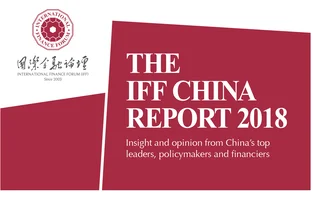
The world-growth engine – Asia’s new role in the global economy
The recovery from the global financial crisis was driven by Asia, in particular China. Deeper integration of China into the world economy and further critical reform is essential to continuing that trend, explains Han Seung-soo, co-chair of the IFF and former prime minister of the Republic of Korea


Finally, after almost a decade, there is good news: the world economy is in recovery. The International Monetary Fund (IMF) revised its forecast for annual economic growth in 2017 and 2018. The global upswing in economic activity reached 3.7% in 2017, and is forecast to reach 3.9% in 2018.
The global financial crisis that began in 2008 led world leaders to form the Group of 20 and seek major reforms of global financial institutions and regulations to ensure the financial system was able to absorb shocks while functioning efficiently. Soon after the onset of the crisis, the G20 played a crucial role in stabilising the situation. As a consequence, painful but important regulatory reforms came into play: the major world economic powers strengthened their own financial regulation and supervision, and introduced countercyclical and microprudential regulations. Disappointingly, the expected recovery was lacklustre – particularly in the most advanced countries – and lasted almost a decade.
In Europe and the US, this long period of low growth and unbalanced recovery was associated with the rise of political risk and anti-globalisation, such as the Brexit vote, which resulted in significant changes in major economies. Despite many challenges during this difficult period, Asia has remained a relatively bright spot and has contributed significantly to the recovery of the global economy. In a global environment of slow growth, Asia – with China in a leading role – emerged as a world economic growth engine; in 2016, Asia contributed 68% of all global growth. In 2017, the International Finance Forum projected that Asia would provide 63% of global growth, with China alone contributing nearly half of that. This has provided room for global economies to pursue difficult structural reforms. Regardless, it is difficult to deny that China’s high growth and positive effects over the past decade have been the most important factors accelerating growth after the crisis.

The less rosy picture of Chinese leverage
However, the story of growth in Asia and China is not all a bed of roses – there are a number of repercussions. Many countries in Asia, including China, have used up part of their existing buffers and are exposing themselves to new vulnerabilities – particularly large debt and pension liabilities, both public and private. For instance, the credit-to-GDP ratio in China is very high by international standards. China’s corporate debt has reached 165% of its GDP, and household debt has also risen rapidly. As a consequence, the probability of variable adjustment continues to increase.
This rapid rise of leverage in China is not a unique case – many emerging and low-income economy countries have also relied heavily on credit and budget expansion. Combined with the global financial crisis, this has resulted in significantly increased leverages. Added to these new vulnerabilities, rapid credit expansion and rising leverages are urgent and critical problems common in Asia, making it difficult to maintain a strong and sustainable momentum in growth.
In this regard, three important Chinese policies were outlined last October at the 19th National Party Congress of the Communist Party of China:
1. Moving away from short-term growth targets. Monetary and fixed policies aimed at supporting high growth have inevitably provided incentives to slow credit rises – particularly in local governments. It is time to emphasise inclusive growth, not high growth.
2. Tackling risks in the financial sector through better co-ordinated regulation and supervision. The establishment of a new regulatory body, the Financial Stability and Development Committee, is a welcome development.
3. Paying particular attention to the quality of assets associated with China’s large foreign investments. In many cases, these investments make up a significant proportion of recipient countries’ GDPs, and have considerably impacted their
medium-term debt sustainability. As such, sustainability, profitability and viability of those projects should be well targeted and properly managed. The stability of China’s financial markets must spread beyond its borders. As the Chinese economy has grown, it has become more integrated with the global economy both in trade and finance.
China is now in the top 10 of trading partners in more than 100 economies, accounting for almost 80% of global GDP. The greater integration of China into the global economy surely means that its performance can be either a blessing or a source of major risk for many countries worldwide.
Despite the aforementioned vulnerabilities and risks, there is no doubt that Asia and China are set to remain key dynamic players in the global economy. China has the all-important resources, knowledge, buffers and political determination to manage the smooth transformation to a more balanced, sustainable economy. This is good for China, good for Asia and good for the world.
Managing financial risks and vulnerabilities is always difficult, and can be very bumpy from time to time. The implementation of critical reform is still essential to the sustainable growth of China and all of Asia.
Only users who have a paid subscription or are part of a corporate subscription are able to print or copy content.
To access these options, along with all other subscription benefits, please contact info@centralbanking.com or view our subscription options here: subscriptions.centralbanking.com/subscribe
You are currently unable to print this content. Please contact info@centralbanking.com to find out more.
You are currently unable to copy this content. Please contact info@centralbanking.com to find out more.
Copyright Infopro Digital Limited. All rights reserved.
As outlined in our terms and conditions, https://www.infopro-digital.com/terms-and-conditions/subscriptions/ (point 2.4), printing is limited to a single copy.
If you would like to purchase additional rights please email info@centralbanking.com test test test
Copyright Infopro Digital Limited. All rights reserved.
You may share this content using our article tools. As outlined in our terms and conditions, https://www.infopro-digital.com/terms-and-conditions/subscriptions/ (clause 2.4), an Authorised User may only make one copy of the materials for their own personal use. You must also comply with the restrictions in clause 2.5.
If you would like to purchase additional rights please email info@centralbanking.com test test test







